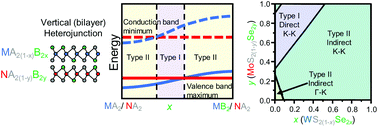Composition-induced type I and direct bandgap transition metal dichalcogenides alloy vertical heterojunctions†
Abstract
While members of the 2D semiconducting transition metal dichalcogenide (TMD) family MX2 (M = {Mo, W}, X = {S, Se}) are promising for device applications, stacked layer (vertical) heterojunctions exhibit features that make them inappropriate for light-emitting applications. Such vertical heterojunctions exhibit type II, rather than the preferred type I band alignment. Using density functional theory calculations, we identify the pseudo-binary and quaternary alloy composition range for which band alignment is type I. While broad regions of composition space lead to type I band alignment, most light-emitting devices require direct bandgaps. We demonstrate that by taking advantage of alloying and/or twisting between layers, a wide range of type I, direct bandgap stacked layer (vertical) heterojunctions are achievable. These results and the underlying method developed here provide new opportunities for TMD vertical heterojunction device optimization and opens the door to new classes of TMD vertical heterojunction device applications.



 Please wait while we load your content...
Please wait while we load your content...